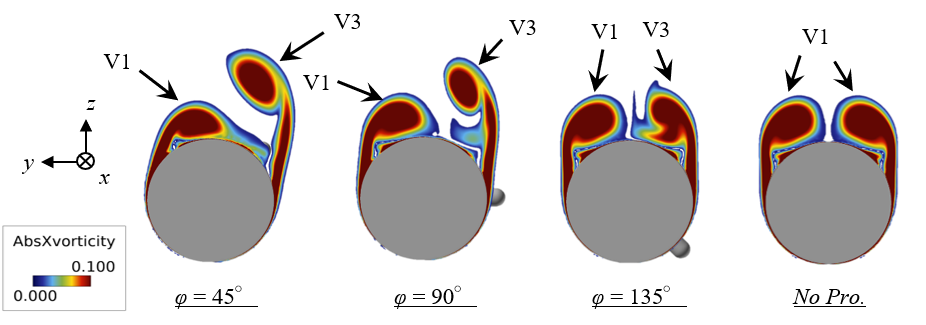The Effect of Protuberant Devices on Aerodynamic Characteristics of Slender Body Vehicle
JAXA Supercomputer System Annual Report April 2018-March 2019
Report Number: R18EACA20
Subject Category: JSS2 Inter-University Research
- Responsible Representative: Keiichi Kitamura, Associate Professor, Yokohama National University
- Contact Information: Toshiaki Harada(harada-toshiaki-vt@ynu.jp)
- Members: Toshiaki Harada, Keiichi Kitamura
Abstract
It is important for rocket developments to quantitatively estimate the influence of protuberances in the flight vehicles which create asymmetry of flow around the vehicles and aerodynamic forces. Using fluid numerical computation, it is expected that we obtain a guideline for the protuberance choice in the future rocket development by conducting systematic and fundamental aerodynamic study on protuberance 1)positions and 2)sizes allowed to arbitrary flight vehicles.
Reference URL
Please refer to ‘YNU Aerodynamics Lab.‘.
Reasons for using JSS2
This study needs expensive numerical fluid analyses around flight vehicles equipped with protuberances. Therefore, it is unrealistic that this scale of numerical calculations be carried out 100 times with workstations in the university, requiring 2.5 million grid points. Therefore, we use JSS2 in order to ensure larger memories and to save the cost of numerical calculations.
Achievements of the Year
The figure shows the pressure coefficient distribution in the cross section at 80% of the total length of the body with the azimuthal angle of protuberance phy = 45 deg., phy = 90 deg., phy = 135 deg. and no projection (No Pro.) At attack of angle (AoA) = 15 deg. The vertical axis is the dimensionless height (z/(D/4)) of the body, and the horizontal axis is the pressure coefficient Cp (phy = 180 deg. is the windward side of the body). Focusing on the port side (solid line) of the body, differences due to the azimuthal angle of protuberance can be seen. This is considered to be due to the separation vortices generated on the protuberance side leaving the body. When the absolute value distribution of the vorticity in the body axis direction is visualized, it can be confirmed that the vortices on the port side are separated from the body as phy decreases. Therefore, the surface pressure was different between the port and the starboard, which contributed to the increase of the side force. In addition, as a result of examining the side force at each azimuthal angle of protuberance phy = 25 deg., it was found that the maximum value is at phy = 45 deg., and the side force can be reduced when the protuberance is located upwind.

Fig.1: Cp distributions surrounding a cross section at x/L = 0.8 and AoA = 15 deg. for each azimuthal angle (phy)

Fig.2: 2D (y-z) planes colored with vorticity magnitude in each case: planes of 0.1 L interval from 0.3L to 1.0L with a Cp surface contour (perspective view) at AoA = 15 deg.

Fig.3: 2D (y-z) planes colored with vorticity magnitude in each azimuthal angle (phy) case and No pro. case at AoA = 15 deg. at x/L = 0.8 plane

Fig.4: Side force coefficient CY vs azimuthal angle (phy) by 15 deg. steps in Front case at AoA = 15 deg
Publications
– Peer-reviewed papers
1) Kawauchi Kazuaki, Toshiaki Harada, Keiichi Kitamura, Satoshi Nonaka, “Experimental and Numerical Investigations of Slender Body Side Force with Asymmetric Protuberances,” Journal of Spacecraft and Rockets (Accepted).
2) Toshiaki Harada, Keiichi Kitamura, Satoshi Nonaka, “Roll Moment Characteristics of Supersonic Flight Vehicle Equipped with Asymmetric Protuberance,” The 31st ISTS Special Issue of Transaction of JSASS (Accepted).
– Non peer-reviewed papers
Toshiaki Harada, Kawauchi Kazuaki, Keiichi Kitamura, Satoshi Nonaka, “Side Force Characteristics of Supersonic Flight Vehicle Equipped with Asymmetric Protuberance,” AIAA Science and Technology Forum 2019, 2019-0299
– Oral Presentations
1. Kazuaki KAWAUCHI, Toshiaki HARADA, Keiichi KITAMURA, Satoshi NONAKA, “Experimental and Numerical Study of Side Force on Slender Body with Asymmetric Protuberance,” Symposium on Flight Mechanics and Astrodynamics
2. Kazuaki KAWAUCHI, Toshiaki HARADA, Keiichi KITAMURA, Satoshi NONAKA, “Wind Tunnel Experiment on Slender body Aerodynamics with Asymmetric Protuberance at Mach 1.5,” JSSUME2018 (15th Joint Symposium between Sister Universities in Mechanical Engineering)
3. Kazuaki KAWAUCHI, Toshiaki HARADA, Keiichi KITAMURA, Satoshi NONAKA, “Supersonic Wind Tunnel Tests on Aerodynamic Characteristics of Slender Body with Asymmetric Protuberance,” the 49th JSASS Annual Meeting
– Poster Presentations
Toshiaki Harada, Kazuaki Kawauchi, Keiichi Kitamura, Satoshi Nonaka, “CFD on Side Force Characteristic of Slender Flight Vehicle with Asymmetric Protuberance,” the 62nd Space Sciences and Technology Conference
Usage of JSS2
Computational Information
- Process Parallelization Methods: MPI
- Thread Parallelization Methods: N/A
- Number of Processes: 320
- Elapsed Time per Case: 8 Hour(s)
Resources Used
Fraction of Usage in Total Resources*1(%): 0.11
Details
Please refer to System Configuration of JSS2 for the system configuration and major specifications of JSS2.
| System Name | Amount of Core Time(core x hours) | Fraction of Usage*2(%) |
|---|---|---|
| SORA-MA | 736,396.53 | 0.09 |
| SORA-PP | 29,040.50 | 0.23 |
| SORA-LM | 2,272.36 | 1.06 |
| SORA-TPP | 0.00 | 0.00 |
| File System Name | Storage Assigned(GiB) | Fraction of Usage*2(%) |
|---|---|---|
| /home | 16.21 | 0.02 |
| /data | 9,344.11 | 0.16 |
| /ltmp | 3,320.31 | 0.28 |
| Archiver Name | Storage Used(TiB) | Fraction of Usage*2(%) |
|---|---|---|
| J-SPACE | 4.75 | 0.17 |
*1: Fraction of Usage in Total Resources: Weighted average of three resource types (Computing, File System, and Archiver).
*2: Fraction of Usage:Percentage of usage relative to each resource used in one year.
JAXA Supercomputer System Annual Report April 2018-March 2019


